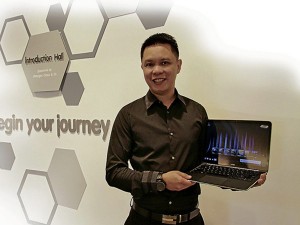Known globally as a source of affordable and efficient computers, Dell is making a buzz with its lifestyle laptop that may come to challenge the MacBook Air.
The Dell XPS 13 Ultrabook is touted as “cool” by its advertisers, and lauded by tech reviewers for its style and performance. The advertising images show young people easily toting the laptop inside a cable car, viewing a movie in a café or at the Fisherman’s Wharf in San Francisco.
“It’s designed and crafted for compactness. You want to move around easily and still want more performance, such as the ability to browse, play movies or videos. For that, you’d need a powerful notebook,” says Christopher Papa, Dell country manager.
He adds that the Ultrabook responds to a trend where people express their individuality through the gadgets they carry. It is targeting the Gen Y, the young professionals and executives who, figuratively speaking, bring their “office” everywhere.
Papa observes that the youth makes a good market for these lifestyle laptops—even if it’s their parents who shell out anywhere from P60,000 to P80,000 for a unit.
“In all, there’s a consumer demand for a laptop that is classy, contemporary, powerful and light.”
Papa points out that among the Ultrabook’s unique selling points are the compact size and big screen. Its 13-inch display has been squeezed into an 11-inch chassis.
Unlike other high-end notebooks made of metal or plastic, the Ultrabook uses a carbon fiber base, the same material that goes into a sports car, thereby making it very light—weighing in at less than 3 pounds. Its patented Gorilla Glass screen by glassmaker Corning, makes it scratch-resistant.
Reviews claim that the Ultrabook boots up faster and the files won’t get corrupted if it is dropped. So far, it’s the only laptop that has a battery gauge. It also has the ability to run for nine hours.
The Ultrabook comes in several variants. The i7 with a powerful processor fetches P79,990 while the i5 with 150 gigabytes costs P59,590. The i5 with 250 gigabytes costs P71,000.
With the Ultrabook, Dell hopes that it can boost its market share in the premium group of the consumer division.
Dell’s premium line accounts for 20 percent of sales in the world. In the Philippines, this high-end category makes only 10 percent of the sales.
Its biggest market is in the corporate and SMB categories, which account for 75 percent of sales.
Papa explains that Dell caters to all price categories and designs according to market requirements. Corporate models are built to last for three years and require more functions. Corporate customers require computers that provide durability, efficiency, security and lots of storage for back-up files. On the other hand, consumers want a laptop that is attractive and prioritize immediate access to the Internet, playing music and movies. They will easily trade up their laptop for the next hottest thing.
Papa cites the IDC global market intelligence firm as saying that Dell is No. 1 in notebooks and desktops.
He attributes Dell’s success in the Philippines to the fact that it addresses the requirements of big companies and entrepreneurs. Vostro, designed for SMBs and home offices fetches P40,000. In the notebook category, the Latitude model, is the most popular in big companies.
“We’ve got the lowest failure rates in commercial notebooks,” he says. “As an extra feature, we provide a system management to monitor the notebooks [to determine] which one works or doesn’t. That makes everything more efficient.”
Dell has a strong presence in business process outsourcing sector.
In the consumer division, Papa says most netbooks in the Philippines are in the entry-level category, retailing from P12,000 to P15,000.
Recently, the prices of newer models have reduced.
He says Dell recently pulled out from the netbook business, not wanting to compromise the quality of its components and craftsmanship.
“We’re after reliability,” says Papa. “We want to offer the best product possible but not necessarily the lowest price.”
Inspiron is the most popular laptop in the consumer category with a price range of P20,000 to P30,000.
When Dell launched the XPS premium line, starting with the 15z notebook, sales exceeded the company’s expectations.
“It became our hero product,” says Charlz Adano, Dell marketing manager. “The people found it attractive with its aluminum finish, but they’re also after the brand’s reliability.”
The succeeding model, the 14z, also designed for professional use was equally met with success last February.
On Dell’s 2012 tack, Papa says that the company will strengthen its medium price laptops while it grows the XPS line. There’s still an untapped market of small and medium businesses in the Philippines with over a million entrepreneurs. For the lifestyle laptops, Filipinos, being quite adaptable, will readily accept the latest XPS models.
“Dell is strong in the corporate market, but for the consumer, we’ve got to increase the brand awareness. The Dell brand is a premium product that’s cost-effective, stylish and lasts for as long as the notebook stays with you,” says Papa.


